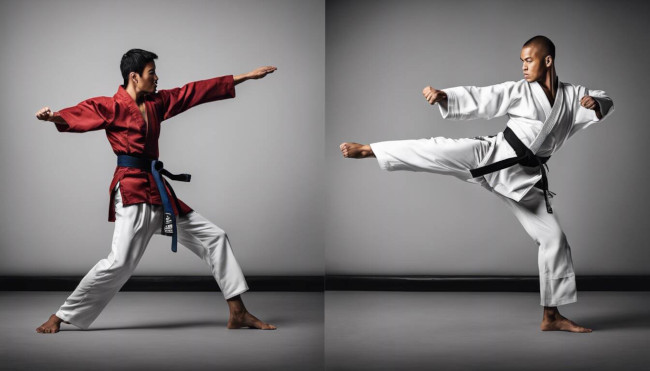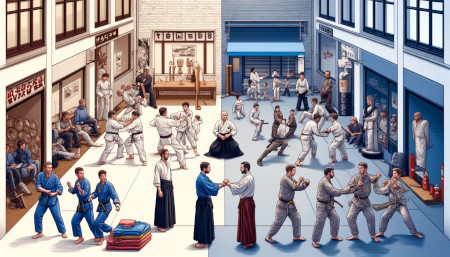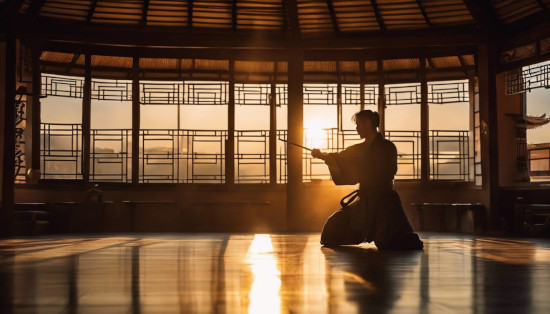The Difference Between Martial Arts and Self Defense

Martial arts is an expansive domain comprising of various structured systems for defense, competition, health, and mental well-being. Self-defense, on the other hand, strictly focuses on practical skills intended for personal protection. The surprising fact is that these two seemingly different areas share a crucial goal of ensuring personal safety. They smoothly tie into each other with martial arts serving as a foundation for self-defense maneuvers. Remember though, at TBOTECH we extend your self-defense arsenal with essential tools to further bolster your personal safety.
While martial arts focus on the practice of specific combat techniques and often involve a competitive or disciplined aspect, self-defense emphasizes practical skills designed to defend against real-life threats. Self-defense training typically concentrates on situational awareness, escape strategies, and effective use of non-lethal tools such as pepper spray and stun guns for personal protection in dangerous situations.

Martial Arts vs Self Defense: Defining Terms
Martial arts and self-defense are often used interchangeably, but they embody distinct concepts. Martial arts cover a wide array of formalized systems and customs of combat. It's an umbrella term that encompasses numerous traditions aimed at honing skills for various purposes such as self-defense, physical wellness, mental fortitude, or even competitive sports.
Expanding on this idea, within this framework, martial arts often include structured techniques like forms and katas, accompanied by controlled sparring sessions. Many martial arts also carry significant cultural and historical value, emphasizing discipline, respect, and personal growth. The holistic nature of martial arts incorporates physical training, mental conditioning, and character development.
On the other hand, self-defense revolves around practical strategies designed to protect oneself from physical harm in real-world scenarios. It focuses on developing instinctive responses and quick thinking to neutralize threats. At TBOTECH, our store offers a variety of self-defense products that serve as valuable tools for personal safety.
It's important to distinguish between the two because while martial arts offer extensive training in combat techniques and tactics for a variety of reasons, including self-defense, the primary goal may not always be immediate protection from harm.
For instance, practicing judo may provide effective self-defense skills, but its main focus is on competition and physical exercise rather than directly addressing real-life threats. On the other hand, self-defense training hones in on practical applications for personal safety rather than a broader approach encompassing cultural significance and long-term skill development.
People often debate which approach is more suitable for personal safety—traditional martial arts or specialized self-defense training. The reality is that both have unique benefits depending on individual needs and circumstances.
Understanding these definitions helps to clarify the nuances between martial arts and self-defense, shedding light on their divergent purposes and guiding principles. Both are valuable in their own right and play distinctive roles in enhancing personal safety and overall well-being.
With a clear understanding of the distinctions between martial arts and self-defense, let's now explore the similarities and differences between these two approaches to personal protection.
Similarities and Differences
At first glance, it might seem like martial arts and self-defense are one and the same. They both revolve around the idea of physical protection and mental fortitude, but there are crucial differences to consider.
Similarities
Martial arts and self-defense share common ground in terms of instilling discipline, confidence, and mindfulness. Both practices train individuals to be aware of their surroundings, develop rapid reflexes, and teach various techniques for dealing with confrontational situations. The physical and mental conditioning provided by these disciplines can be equally beneficial in enhancing overall personal safety and well-being.
Think of both as toolkits- each designed to equip you with the necessary skills to stay safe and act responsibly when faced with danger. Just as a carpenter requires different tools for various tasks, martial arts and self-defense provide different strategies and tactics for different kinds of threats.
Differences
The critical divergence between the two lies in their focus and intent. Martial arts encompass a broad range of skills, including self-defense techniques, but their primary objective is not limited to practical defense alone. It is more about achieving physical fitness, mastering intricate movements, and embracing a comprehensive philosophy of self-improvement.
In contrast, self-defense methods are tailor-made for real-world scenarios, placing immediate emphasis on swift, efficient responses to threats rather than elaborate rituals or sportive combat.
To put it simply, if martial arts were a sprawling university offering a holistic education in personal development, self-defense would be an express course tailored exclusively to crisis management.
Understanding these similarities and differences helps individuals make informed decisions about which path aligns best with their goals of self-improvement and personal safety. Both disciplines have their unique advantages and are beneficial in their own right.
As we have gained insights into the distinctions between martial arts and self-defense, let's now shift our focus to exploring the practical applications of these skills in ensuring personal safety.
Applications in Personal Safety
When it comes to personal safety, the principles of martial arts and self-defense offer different but complementary approaches. Martial arts training aims to develop mental discipline, physical fitness, and holistic personal growth. The emphasis is not solely on responding to physical threats; it also focuses on cultivating a mindset of conflict avoidance and resolution.
This holistic approach encourages practitioners to actively seek solutions other than physical confrontation. They are taught to assess situations, avoid risky environments when possible, and employ de-escalation techniques to diffuse confrontations before they escalate.
Versatility in Response
Martial artists learn how to defend themselves if necessary, but they also focus on understanding opponents and attempting to defuse conflicts peacefully. Training in martial arts often includes varied forms like katas and sparring, which develop agility, coordination, and awareness—all useful qualities for avoiding dangerous situations or getting out of them unharmed whenever possible.
On the other hand, the self-defense approach concentrates on practical techniques designed for swift and effective protection against physical threats. Rather than focusing on personal development and the cultivation of non-confrontational strategies, self-defense is all about direct response when faced with danger.
The training in self-defense typically includes learning how to react swiftly when confronted with an attacker or a dangerous situation. The emphasis is placed on situations where avoiding or escaping from confrontation is not always feasible, especially in cases where immediate action is required for survival.
Quick Decision Making
In this regard, self-defense education involves training individuals in rapid decision-making and effective use of force when necessary for self-preservation. It equips individuals with physical techniques that are tailored for swift incapacitation or escape without prolonging physical engagement.
Despite these differing approaches, both martial arts training and self-defense education play significant roles in personal safety by preparing individuals to deal with potential threats effectively—whether through avoidance strategies or direct response technique application.
As we transition into exploring the various training regimens and techniques used in both martial arts and modern self-defense methods, it's important to recognize the crucial role each plays in empowering individuals with the skills needed to safeguard themselves in today's unpredictable world.
Training Regimens and Techniques
When it comes to martial arts training, traditional methods often emphasize muscle memory, form, and controlled sparring. This approach serves to cultivate physical fitness and ingrain precise movement and technique. Forms, or "katas," are sequences of movements that help students develop balance, coordination, and focus. They often symbolize a battle against imaginary opponents and enable practitioners to apply different techniques in a continuous flow.
Muscle Memory in Martial Arts
Through repetitive practice, martial artists gain muscle memory, a remarkable capability in combat situations. It enables them to execute movements with precision and speed without conscious effort. Once these techniques are ingrained into muscle memory through diligent practice, they become second nature, akin to learning how to ride a bike.
Additionally, controlled sparring allows practitioners to put their skills into action within a safe environment. By simulating real combat scenarios under supervised conditions, students can refine their offensive and defensive techniques while building discipline and fortitude. This type of training has lasting benefits beyond self-defense. The discipline acquired during martial arts training can translate into greater resilience, determination, and mental agility in everyday challenges. Moreover, the physical fitness achieved through martial arts can lead to improved health and well-being.
In contrast, self-defense training differs in its emphasis on practical application and response to real-life threats.
Practical Techniques in Self-Defense
Self-defense training typically involves studying common attack scenarios such as grabs, chokes, or strikes, and learning effective ways to respond to these situations. This includes understanding vulnerable areas of the body and deploying quick, effective methods to protect oneself or escape from danger. Moreover, self-defense instruction teaches individuals how to utilize readily available objects for protection or escape. By harnessing their surroundings and employing straightforward yet potent defensive techniques, individuals can bolster their readiness for unpredictable situations.
In summary, while martial arts training centers around refining technique through disciplined practice and controlled sparring, self-defense instruction emphasizes practical scenarios and quick responses to potential threats. Both approaches offer valuable skills for personal safety but cater to different goals and contexts.
In the pursuit of mastery over the mind and body lies an unyielding devotion to honor, discipline, and respect. Let's now venture into the heart of these virtues as they are embodied within the practice of combat arts.
Honor, Discipline and Respect in Practice

The practice of martial arts and self-defense extends beyond physical techniques; it encompasses the development of character traits essential for personal growth and community contribution. Respect for others forms the bedrock of both disciplines. In martial arts, students are taught to bow as a sign of mutual respect between themselves and their instructors, symbolizing a commitment to humility and acknowledging the wisdom imparted by those with more experience. This simple act serves as a constant reminder of valuing the guidance provided not just within the training halls but also in broader life experiences. Moreover, respect in self-defense requires an understanding of personal boundaries and empathy towards others, advocating for nonviolent conflict resolution whenever possible.
Discipline is another fundamental principle deeply embedded within both martial arts and self-defense. The rigorous nature of regular practice encourages individuals to develop mental fortitude, focus, and self-control. From mastering intricate forms in martial arts to refining one's situational awareness in self-defense, discipline permeates every aspect of training. The application of discipline extends beyond training sessions to daily life, promoting consistency in pursuit of personal goals through unwavering commitment. This also reinforces resilience against adversity and fosters perseverance, equipping practitioners with invaluable life skills to face challenges head-on.
Closely intertwined with discipline is the virtue of honor, which emphasizes upholding ethical standards and personal integrity. In martial arts, honor represents the willingness to acknowledge mistakes and take responsibility for one's actions while remaining steadfastly devoted to one's moral compass. It reflects the dignified conduct expected not only during sparring but in all interactions, promoting honor as a way of life rather than a mere concept. Similarly, honor in self-defense advocates for ethical decision-making and prudent judgment when confronted with potential threats. It underscores the significance of using force judiciously, emphasizing de-escalation tactics and proportional responses to safeguard oneself without compromising ethical values.
By emphasizing respect, discipline, and honor, both martial arts and self-defense underscore the cultivation of holistic virtues essential for personal growth and harmonious coexistence. These principles extend well beyond physical combat, shaping individuals into resilient, virtuous contributors to their communities.
Martial Arts Styles vs Self Defense Methods
Martial arts styles are more than just physical techniques; they encompass rich traditions, philosophies, and cultural significance. Each style, whether it's karate, taekwondo, muay thai, judo, or kung fu, has its own unique set of movements, principles, and rituals that have been passed down through generations. These traditions often emphasize discipline, respect, and personal development as much as they do combat techniques.
For example, karate is known for emphasizing powerful strikes and defensive blocks while promoting mental discipline and spiritual growth. On the other hand, kung fu incorporates a wide range of fighting styles and techniques, often inspired by animals like the snake or crane. The focus in each style varies greatly and can offer a lot to practitioners who wish to explore the historical elements of martial arts.
Self-defense methods, on the other hand, are focused on practical and immediate application in real-world self-protection situations. While these methods may draw from multiple martial arts disciplines, they are tailored specifically for self-protection rather than the cultural and traditional aspects of martial arts. This means that self-defense training often focuses on quick, effective techniques to escape from dangerous situations rather than prolonged combat or spiritual development.
It's all about efficiency in self-defense—techniques are honed for maximal effect with minimal effort in order to neutralize threats quickly. Rather than focusing solely on form or tradition, practicality is key. This includes learning how to identify potential threats, understanding the body's vulnerable points, and practicing situational awareness.
The goal here is not to engage in combat for sport or discipline; it's to get out of dangerous situations as quickly and safely as possible. To achieve this goal, self-defense methods often incorporate strategies from various martial arts styles and adapt them to real-world scenarios. This allows practitioners to acquire a well-rounded skill set that addresses a wide range of potential threats.
By recognizing the distinctions between martial arts styles and self-defense methods, individuals can make informed decisions about the type of training that best aligns with their goals—whether it's pursuing the deep cultural roots of a specific martial art or mastering practical techniques for real-world protection.
Understanding the nuances between martial arts and self-defense empowers individuals to choose the path most suited to their personal objectives and safety needs.
Add your comment now!
Post Comment



